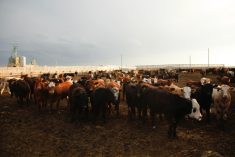Compared to last week, western Canadian yearling prices traded $3-$5 on either side of unchanged. Auction market volumes are growing in Saskatchewan and Manitoba; however, central Alberta prices held a definite premium of $8-$10 over the eastern Prairie regions. Ontario orders are starting to surface in Manitoba but prices were out of reach with Alberta feedlots’ interest in the western Prairies. Alberta packers were buying fed cattle in the range of $139 to $141 last week. Negative feeding margins are having little effect on yearling prices, although calves are down about $12 on average from the fall of 2018.
Read Also

U.S. grains: Wheat futures rise on supply snags in top-exporter Russia
U.S. wheat futures closed higher on Thursday on concerns over the limited availability of supplies for export in Russia, analysts said.
Comments from buyers reflect that higher-quality cattle are demanding a premium as overall supplies are down from last year. Many farmers are planning to background their calves, given the sharp year-over-year decline in barley prices. On the flip side, Lethbridge barley in the range of $210-$215 per tonne is a breath of fresh air after reaching highs of $300 per tonne earlier in summer.
Once again, central Alberta prices were the highest in the country last week, with red white-face medium-frame lower-flesh steers weighing just under 900 lbs. dropping the gavel at $186; larger-frame lower-flesh Angus-blended steers averaging 810 lbs. were sold for $200. In Manitoba, larger-frame Charolais heifers averaging 850 lbs. were valued at $178 while a larger group of tan mixed steers weighing just under 800 lbs. reached up to $196.
We’re starting to see more calves come on stream and prices for 500- to 650-lb. feeders were relatively flat across the Prairies. However, the market is not well established. In southern Alberta, mixed steers weighing 510 lbs. were quoted at $225; red mixed steers weighing 575 lbs. were valued at $216. In southeastern Saskatchewan, 560-lb. mixed steers were quoted at $214.
April live cattle futures are trading near contract lows of US$110, down from the contract highs earlier in April near US$127. Western Canadian yearlings cannot stay near 52-week highs with weakness in the deferred fed cattle market.
— Jerry Klassen manages the Canadian office of Swiss-based grain trader GAP SA Grains and Produits Ltd. and is president and founder of Resilient Capital, specializing in proprietary commodity futures trading and market analysis. Jerry consults with feedlots on risk management and writes a weekly cattle market commentary. He can be reached at 204-504-8339 or via his website at ResilCapital.com.















